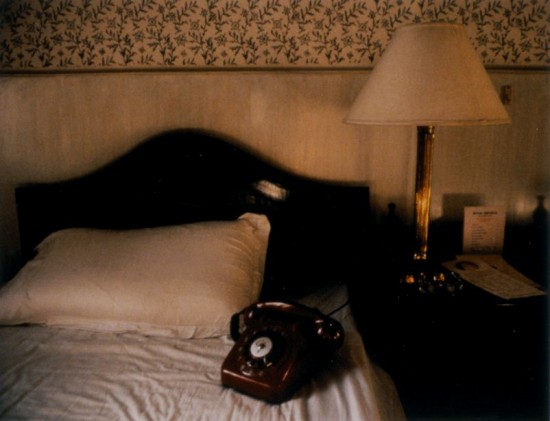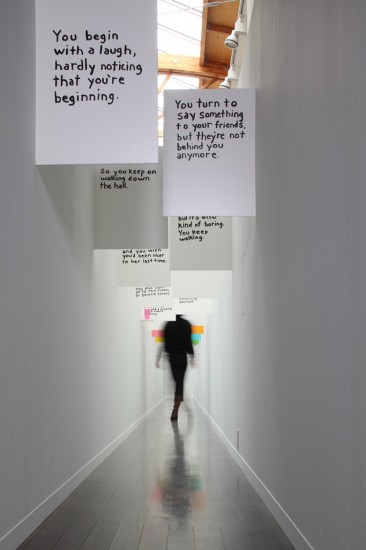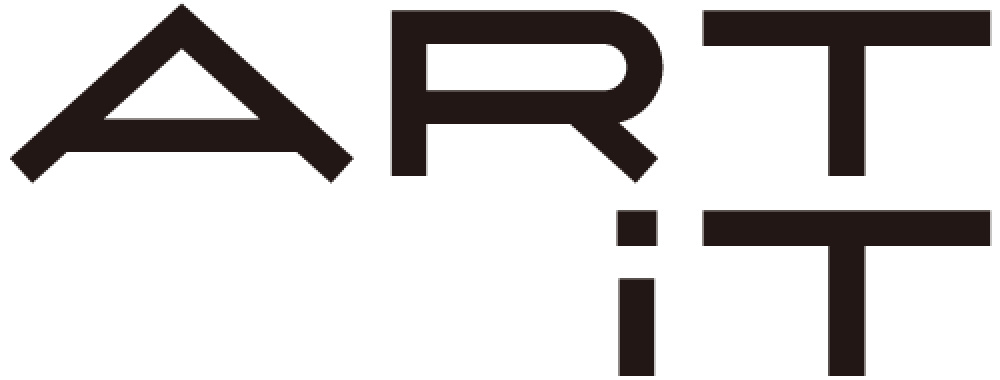Spinning the Word: Sophie Calle and Miranda July from the Hara Museum Collection
March 16 (Saturday) – June 26 (Wednesday), 2013
Hara Museum ARC Galleries A, B and C
(2855-1, Kanai, Shibukawa-shi, Gunma 377-0027)

Sophie Calle, Exquisite Pain , 1999
© ADAGP Paris,2013 Courtesy Galerie Perrotin, Hong Kong & Paris – Gallery Koyanagi, Tokyo
Hara Museum ARC is proud to present an exhibition featuring large-scale installations by two of the world’s most dynamic artists: Exquisite Pain by Sophie Calle and The Hallway by Miranda July. Sophie Calle, a major French artist and cutting-edge figure on the international stage, first created Exquisite Pain for her solo exhibition at the Hara Museum in 1999. Consisting of photographs and embroidered Japanese text, the installation presents a vivid record of her journey from Paris to Japan and the subsequent pain of her heartbreak. Miranda July, a multi-talented artist who occupies a leading position within a new generation of artists in America, first presented The Hallway, a handwritten, introspective missive about universal aspects of life, at the Yokohama Triennial (2008) where it created a sensation. This show represents a rare opportunity to experience back to back works by artists who continue to redefine the boundaries of contemporary art as they traverse the line between fact and fiction.
Concurrent Exhibition at the Hara Museum of Contemporary Art
Taking place at the same time will be Sophie Calle’s solo exhibition at the Hara Museum in Tokyo, Sophie Calle, For the Last and First Time (March 20 (Wednesday) – June 30 (Sunday)). This show will consist of two parts: The Last Image (2010), an installation that weaves together text and photographs taken by the artist about people who have lost the power of sight, and Voir la mer (See the sea) (2011), another installation which captures on film the expression of persons seeing the ocean for the first time. Transport between the two venues by shuttle bus is being planned.
Exhibition Details
Title: Spinning the Word: Sophie Calle and Miranda July from the Hara Museum Collection
Dates: March 16 (Saturday) – June 26 (Wednesday), 2013
Place: Hara Museum ARC (2855-1, Kanai, Shibukawa-shi, Gunma 377-0027)
Tel: 0279-24-6585 E-mail: arc@haramuseum.or.jp
Organized by: Hara Museum of Contemporary Art
http://www.haramuseum.or.jp (official website) http://mobile.haramuseum.or.jp (mobile site)
https://www.art-it.asia/en/u/HaraMuseum_e (blog)
http://twitter.com/HaraMuseumARC (Twitter)
Hours: 9:30 am – 4:30 pm *Last entry 30 minutes before closing.
Closed: Thursdays (except March 28 and May 2)
*Closed temporarily in the event of severe weather.
Admission: General (over 12) 1,000 yen; children (over 3) 500 yen; 10% discount for a group of 20 or more.
*Children must be accompanied by an adult.
*Combination ticket for Hara Museum ARC and Ikaho Green Bokujo ranch: General 1,800 yen; Children 900 yen.
Getting There:
By train: Take the Joetsu Shinkansen to Takasaki, change to the Joestu Line, and disembark at Shibukawa. From Shibukawa, ARC is 10 minutes away by taxi or 15 minutes by bus (take the Ikaho Onsen bus to “Green Bokujo Mae”). By car: 8 kilometers (about 15 minutes) from the Kan-etsu Expressway Shibukawa Ikaho Interchange (in the direction of Ikaho Onsen).
Related Events:
Bus Tours to Hara Museum ARC
Several bus tours from Tokyo to Hara Museum ARC will be conducted during the exhibition.
Screening Event at the Hara Museum: Short Films by Miranda July
*Details for the events will be posted on the Hara Museum website at a later date.
Who Is Sophie Calle?
Calle was born in Paris in 1953. In her late-teens, she left home to wander for seven years, returning to Paris at the age of 26. From that time, she began creating, and from 1980, she began to exhibit. She has won fame largely for her highly narrative work composed of photographs and language. For the project The Sleepers (1979), Calle photographed and interviewed 24 strangers whom she had invited to come to her home and sleep in her bed. For The Hotel (1981), Calle worked as a chambermaid at a hotel in Venice where she photographed the rooms of the hotel guests. The Address Book (1983) refers to an address book found by the artist. Calling the people listed in the book, Calle conducted interviews about the owner and then published them in the French daily newspaper Libération. These projects, including those made during the 1990s such as True Stories and Suite Venitienne, were intriguing mixtures of fact and fiction. During this time, she also began working on a series about persons without sight, beginning with The Blind (1986). It was a profound examination into the nature of sight and perception, which lie at the very foundation of art.
As one of France’s leading artists and a leading figure in the world of art, she has held solo exhibitions at major museums such as the Whitechapel Gallery (2009) and the Centre Pompidou (2003) and has represented her country at the 52nd Venice Biennale (2007) and other international art events. In addition to these various semi-autobiographical series, Calle has also engaged in collaborative projects with others, including the novelist Paul Auster, and has made films such as Double Blind, which she directed and appeared in. These works, which push the boundaries of contemporary art, remain a focus of much attention today.
In Japan, she has held several solo exhibitions, including Exquisite Pain at the Hara Museum of Contemporary Art, Tokyo and an exhibition at the Toyota Municipal Museum of Art (2003). Her work has also appeared in such group exhibitions as Beyond the photographic frame / 11 recent works (1990, Art Tower Mito, Ibaraki) and Images in Transition: Photographic Representations in the Eighties (1990, National Museum of Modern Art, Kyoto National Museum of Modern Art, Tokyo). She currently lives in Malakoff on the outskirts of Paris.
About Exquisite Pain
This installation consists of two parts. In part one (Countdown), letters to her most beloved person and photographs are used to relate the story of the worse day of her life. Part two (Countup) is the story of her gradual recovery, which she achieved by sharing her story of hurt with other people and then listening in turn to their stories about the worse experience of their lives. These many stories–of lost love, of lost eyesight, of the birth of a crippled child–are embroidered with black thread onto white sheets and hung on the gallery walls. Exquisite Pain was presented 14 years ago in the solo exhibition of the same name at the Hara Museum. The unfolding of this part of her life and her encounter with the lives of others undoubtedly touched the hearts of many viewers. In her work, however, the fuzzy distinction between fact and fiction underscores the danger of unquestioning belief.
Who is Miranda July?
Miranda July is a filmmaker, artist, and writer. She was born in 1974 in Vermont and grew up in Berkeley, California. Both her parents were writers who ran a publishing house. After graduating from high school, she went the University of California, Santa Cruz, dropped out, and moved to Portland, Oregon where she worked as a performance artist. From 1997, she began to make movies. Me and You and Everyone We Know (2005), which she wrote, directed and starred in, won a special jury prize at the Sundance Film Festival (2005) and prizes in four categories, including the Camera d’Or (for first-time directors) at the Cannes Film Festival, propelling her into the limelight. Her second and most recent feature-length movie, which she wrote, directed and starred in, is The Future, which is presently being screened at the Theater Image Forum (Shibuya, Tokyo). It has been selected for the Competition section at the Berlin International Film Festival.
July’s multifaceted activities include performance art, web-based art and sound (voice) art. Her projects have been presented at sites such as the Museum of Modern Art, the Guggenheim Museum, the Venice Biennale, and the Whitney Biennial. July created the participatory website, learningtoloveyoumore, with artist Harrell Fletcher and a companion book was published in 2007 (Prestel). This work is now in collection of The San Francisco Museum of Modern Art.
In 2008, July presented The Hallway at the Yokohama Triennale in Japan, where it caused a sensation. In 2009, she designed the interactive sculpture garden Eleven Heavy Things for the Venice Biennale in 2009. This was later installed in Union Square in New York and is currently on display at the Museum of Contemporary Art, Los Angeles.
From 2001, she began publishing fiction in such publications as The Paris Review, The New Yorker and Harper’s. Her first collection of stories, No One Belongs Here More Than You (2007), won the Frank O′Connor International Short Story Award and has been published in twenty countries. Her latest book, It Chooses You (2011), is scheduled to be published in Japan by Shinchosha (translated by Sachiko Kishimoto). She currently lives in Los Angeles.

Miranda July, The Hallway, 2008
About The Hallway
A 125 foot hallway lined with fifty wooden signs, hand-painted with text. As the viewer/participant walks down the seemingly endless hall, weaving between the signs, the text acts as an internal voice, ″It’s too late to go back now, but the end seems far away…″ The ″you″ in text realizes that you’ll be walking down this hallway for the rest of your life. And like life, the hall is filled with indecision, disappointment, boredom and joy – and it does end. (English in one direction, Japanese in the other.)
(From the website YOU OBVIOUSLY KNOW WHAT I’M TALKING ABOUT http://mirandajuly.com/art)
